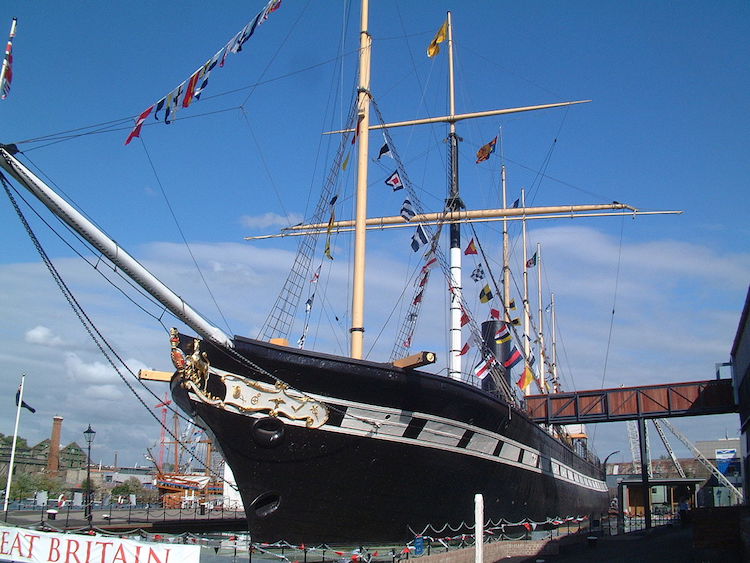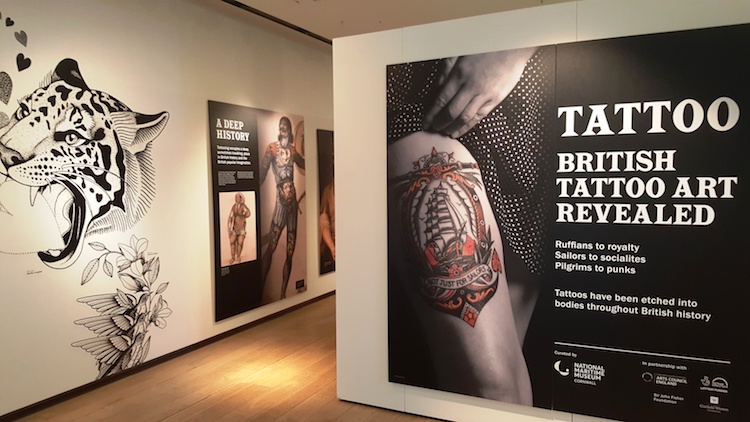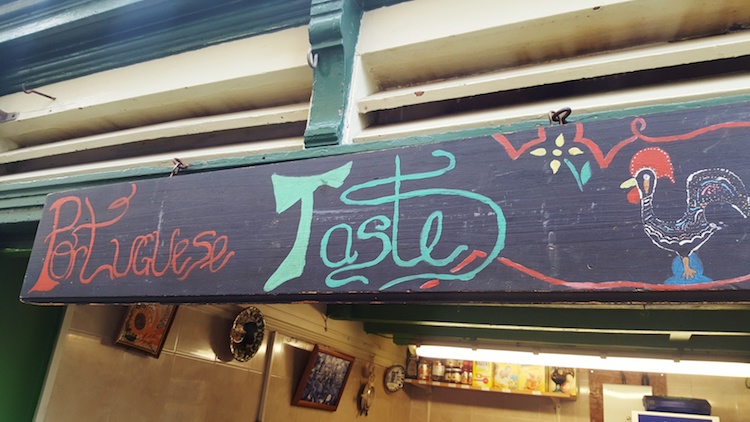The quirky city lovingly called “Brizzle” by its locals is home to many a notable resident. One of them: a 9.5 ton bell named George which has its own Twitter account
Bath and Bristol have been peaceful neighbours throughout time, but developed in starkly contrasting directions. If Bath is all about laid-back chic, elegant spas, and noble history, Bristol is unashamedly modern, industrial, and bold. First time visitors to this bustling city, which pushes the half-million inhabitants mark, pick up a distinct flavour of New York City or Baltimore. And it doesn’t take much to find out there is actually more than just a kernel of truth to it.
Much of Bristol’s early history developed similarly to that of Bath. But its strategic location close to the eponymous Channel which itself gives way to the Atlantic Ocean has made of Bristol a maritime merchant city early on. From the 12th century on, regular busy trade exchange with Ireland, France and the Iberian peninsula laid the foundation to prosperity. By the mid 1300s, Bristol was England’s third-largest town after London and York.
Bristol’s (In)Famous Sons and their Lasting Legacies
All this seafaring knowhow came in handy after the discovery of the American continent. Five years after Columbus reached the Caribbean in 1492, his Italian fellow countryman Giovanni Caboto, or locally known as John Cabot, left from Bristol harbour and would become the first European to set foot onto North American soil.
Cabot’s royal patent, issued by King Henry VII in 1496, stated that all future expeditions should be undertaken from Bristol. It also stipulated that the commerce resulting from any discoveries must be conducted with England alone, with goods only being brought in through Bristol, making the maritime centre effectively a monopoly port, with sole right to engage in colonial trade. Soon, the Bristol port was second only to London in importance.
A couple of centuries later, this would have an impact on Bristol and thousands of lives in ways that no one had ever imagined. Following the British colonization in the Caribbean and the Americas, slaves were an increasingly important commodity, and throughout the 18th century Bristol was a central port for slave ships toward the New World. While this helped the city grow and prosper, it also left a permanent stain on its annals. Today, much is done to recall the plight of those wretched souls and honour their lives, and if you wander through the city with open eyes you will find numerous references to Bristol’s Black history. One such place is Broad Quay House, on Bristol’s waterfront in the heart of the city, where ornate plaques, called roundels, subtly recall the merchant trade, including that terrible era.


If trading was almost every 17th century citizen’s go-to choice to make a living in the port city, one of them went down a different path. His name: Blackbeard, his job: pirate. His choice of career was as questionable as his appearance. As one chronicler describes him, “He allowed his monstrous mane to grow to an extravagant length, and he was accustomed to braiding it into little pigtails, tied with ribbons of various colours. To finish off his intimidating look, he tucked lit fuses underneath his hat.” Bristolians have always proudly defended their reputation of being different…. If you want to get close up and personal with this famous swashbuckler, put a parrot on your shoulder and render thee to The Hatchet Inn on historic Frogmore Street in the harbor area. Dating to 1606, this was Blackbeard’s watering hole, and local lore has it that the front door is covered in human skin, now hidden underneath layers of paint.
Another, much more savory character, who contributed to Bristol’s fame, was Isambard Kingdom Brunel (1806-1859). The English-born engineer of French heritage left two monuments that to this day are still the city’s pride and joy: the wrought-iron Clifton Suspension Bridge spanning the Avon Gorge and the River Avon, is a 19th century marvel of engineering. And his SS Great Britain, “the ship that changed the world”, accumulates records: The largest steam ship in the world when she was built, she was also the first iron-hulled, screw-propelled passenger ocean liner. She now proudly sits in the Bristol Dry docks, open to visitors. You can even climb the rigging if you’re so inclined (and don’t suffer from vertigo).


In a BBC public poll to determine the “100 Greatest Britons“, Brunel was placed second only to Sir Winston Churchill. And while the Suspension Bridge is remarkable for its design, did you know it was also the scene of the world’s first ever bungee jump, back in 1979?
In every century since the Middle Ages, there has always been one name that marked Bristol’s history and his era, and our current times are no exception. Modern day celebrities from Bristol include Cary Grant, JK Rowling, John Cleese, and Trump (no, not THAT one – but Judd, the snooker champion, unrelated to his American namesake) who has hit more than 450 century breaks during his career. And not to forget Massive Attack, a staple of the Bristol and world music scenes since 1988.
But the biggest of them all: Banksy. He may be anonymous and elusive, known only for his work, but you can find his signature all over town. The Visit Bristol tourism office features a great walking tour on his trails. And right in time for (postponed, or maybe never…) Brexit on March 29, the Bristol Museum re-unveiled one of his all-time greatest works … created ten years ago, but more pertinent than ever.

Culture Vultures’ Bristol
While we’re on the subject of museums, there are some that are entirely unmissable, no matter how short your stay. But before we go into that, it is high time to say Thank You to one of the city’s finest ambassadors, Yoma Smith (who you just saw in the video above). A trustee of Bristol Museums Development Trust and a walking, talking encyclopedia of all things Bristol, she spared us hours of her precious time to show us around and tell us the back story of her city with so much passion and enthusiasm that we couldn’t help but falling in love with it, too.
But back to museums, and by golly, there are some spectacular ones. Assuming you only have a couple of days in town (big mistake in the first place!) you will have to narrow them down to two or three, but they are so fabulous that they will take up the better part of your day.
The Bristol Museum and Art Gallery houses tens of thousands of artifacts of art, nature and history under one roof. Egyptian mummies, dinosaurs, European Old Masters, artisan pottery, glass and ceramics… it’s all here. But as if that were not enough, there are currently no less than four temporary exhibits, the grandest of which is undoubtedly the one honouring the 500th anniversary of Leonardo da Vinci’s death. Beholding the genius’ original works is awe-inspiring, especially in a well-curated setting like here. From landmark anatomical studies to whimsical pages, the drawings reveal his qualities as a dreamer, note-taker, designer and above all, an insatiably curious observer of the world around him. They are among the most diverse and technically accomplished in the entire history of art.

If after all these marvels you still have time for another cultural hotspot, wander over to the Waterfront. You may choose the route via Brandon Hill and Cabot Tower, where spectacular panoramic views reward your climbing efforts. Courtesy of the hill’s particular micro climate, you’ll also see plants there that otherwise only grow in Africa or the Caribbean. An alternative way down to the docks is via the gorgeous Bristol Cathedral, a jewel of medieval architecture unto itself. Spend some time exploring it – unlike many of its peers elsewhere, there is no admission fee and it is open to everyone of whatever creed, orientation or origin. And don’t forget to visit the garden which also doubles as a romantic cemetery. What a peaceful and quiet place to sit, rest, and contemplate in the middle of a bustling city.
Your forces duly recouped, head over to the docks area which has been transformed into a giant cultural hub complete with galleries, bars and restaurants, arts centres (do stop at the Arnolfini Centre for Contemporary Arts!) and by way of the Cabot statue, carry on to M Shed. Forget the fact that this is a museum, this is rather a micro cosmos of all things Bristolian, presented in a joyful, exuberant way. And yes, Banksy, is on display, too … But to us, the highlight was the fantastic (temporary) tattoo exhibit on the second floor. This is a Must for anyone who sports ink but even if you don’t, you’ll still fall in crazy love with the art.


As you discover this neighbourhood, you may find a curious plaque, telling you that Waterside Plaza in New York City was built on the rubble of bombed-out Bristol. An identical plaque sits in the Big Apple on the site that is “a little bit of England”. And it makes sense. These two cities do have a lot in common in their vibrancy, multiethnicity, and culture. In either one you catch a distinct whiff of the other. Other American East Coast cities, notably Baltimore, also have more than just a fleeting resemblance to Bristol, showing that the English city served as a blueprint for American urban architects as early as the 16th century.
You have the energy for one more museum? Make it Aerospace Bristol where you can currently check out a special exhibit in honour of the legendary Concorde’s 50th anniversary year. It was right here, in Bristol, that the world’s first commercial supersonic jet was designed and built, and took off on its maiden voyage on 9 April, 1969.
From museums on to the performing arts: no cultural roundup of the shortest of tours is complete without a mention of THE most sacred venue in town, the Bristol Old Vic. Built in 1766, this is the oldest continuously working theatre in the English speaking world, and today it elegantly bridges time by preserving the historic front and adding on a new contemporary space which simultaneously serves as the theatre’s lobby and a bar.

When the theatre first opened it was technically illegal as it didn’t have the necessary Royal Patent, so productions were curiously referred to as “concerts with a specimen of rhetoric”. Because of this, the building was deliberately hidden away with no direct access to the street. To gain admission people would knock on the door of a house, belonging to a certain Mr Foote, then wander through his backyard to get in. A bit like gaining access to one of Bristol’s speakeasy bars then… And as if to show that Bristolians were into street art well before Banksy, during the theatre’s recent refurbishment archaeologists discovered all sorts of ancient treasures, from pig feet and clay pipes … to some 18th-century graffiti! And yes, like any self-respecting theatre, the Bristol Old Vic is also said to have its own ghost, although we could not confirm its presence during our visit – but maybe that was because we were so absorbed in Shakespeare’s Richard III play that we were lucky enough to catch.
For completeness’ sake, St. George’s concert hall with its otherworldly acoustics and a sensation lineup every season also deserves an honorable mention. But in all fairness, Bristol’s cultural life, with all its theatres, cinemas, music halls, and libraries should be the subject of a compendium that far exceeds the limits of this humble write-up.
Time to Refuel
When it comes to hotels and eateries, you are spoilt for choice here! E pluribus unum when it comes to a place to rest your weary head. Brooks Guesthouse is one of those places that leave a lasting memory. For one, it couldn’t be any more central – just minutes from the waterfront and smack dab in the middle of the famous, centuries-old St. Nicholas market, which is a half-day sight in itself. But it also has an original concept: along with conventional hotel rooms, it sporting caravans (or “rockets”) on the rooftop for those who are into (luxury) camping. If you opt for one of those, you’ll have to make some concessions in terms of space and traditional creature comfort but you will be rewarded with great views of Bristol’s city skyline. Brook’s breakfast is famous for a reason, and its staff is exceptionally nice. The perfect place to hang for a couple of nights.



In a city that has more coffee shops than pubs (at least it seemed to us), there is no shortage of places to grab a quick snack or lunch on the go. If you are out for a quick and yummy bite, you could do much worse than browse the eateries at St. Nicholas market (we actually quite fancied the little “Portuguese Taste” mom and pop stall, with a delicious chicken piri piri, and pasteis de nata so good you’ll want you sign your first-born over to the owners in exchange for another one.)
But if you’re really after a special treat, we highly recommend The Florist, a discovery that we owe, once again, to Yoma Smith. Set across all three floors of a classic townhouse, this cocktail bar-cum-eatery is a pleasant assault on the senses, from its decoration down to its food. And if you are lucky enough to be served by the extraordinarily handsome and charming Yassim, your dinner is going to be a guaranteed success.
Summa summarum
Goodness, what a brilliant city! We could only barely scratch the surface here, and we do regret that we did not have more time – way more time! – in vibrant, fascinating, dynamic, amazing, and hip Bristol. A feast for the senses, from its gorgeous architecture to delectable meals and the charming if incomprehensible accent. “Brizzle, yerl gert lush, me babber” (meaning something like “I ♥ Bristol”) and we’ll be back before you know it. As for you, go and check in with the friendly folks at the Visit Bristol tourism office for even more tips and ideas. And remember, to get the best of two worlds, make it a Bristol and Bath double. But do bring time with you, lots of it …
PS: we weren’t kidding when we said that Bristol has a community horological information transfer device by the name of Great George, dwelling in the tower of the University of the Wills Memorial Building. Check George’s Twitter account for news and tongue-in-cheek comments on current affairs…
Read our first instalment all about Bristol’s neighbour Bath.
![]()
All photos courtesy and © Natja Igney except Clifton Suspension Bridge by User Arpingstone on en.wikipedia – Picture taken by Adrian Pingstone in October 2003 and placed in the public domain; photo of SS Great Britain by mattbuck., CC BY-SA 3.0, Link




Leave a Reply